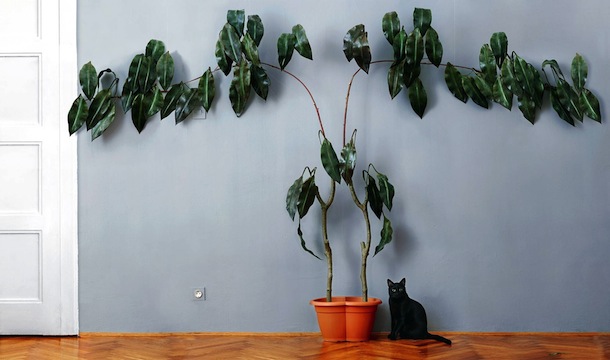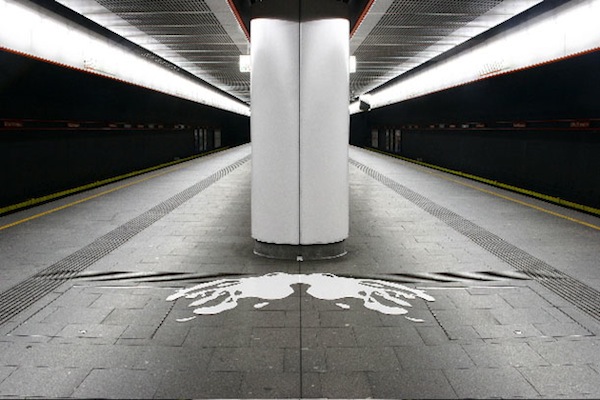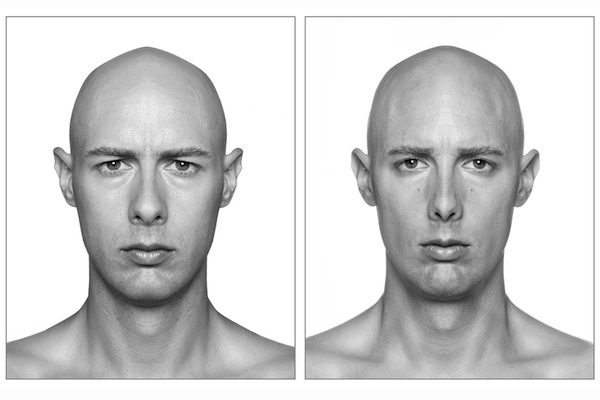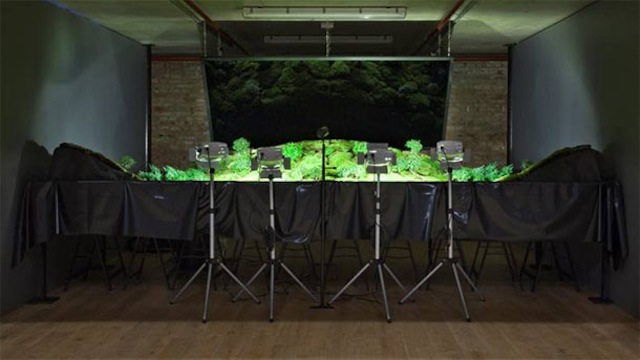Art
Kristina Lenard: Crafting a Living Image
Through photography and the methodical construction of almost perfectly symmetrical installations, artist Kristina Lenard creates self-sustainable living systems and investigates how we perceive what we see. Though Lenard is known for her photography, her photographs are actually the culmination of a lengthy and intensive creative process.
Lenard, who studied sculpture while at the Academy of Visual Art in Zagreb, says that her work is a fusion of the two media: she uses her knowledge of sculpture to set up an installation, and then she photographs it. With Interieur, one of the photographs in her series Photosynthesis, for example, she cut apart two pots and then glued them back together to create an illusion of a digitally manipulated photograph.
It might be hard to believe at first glance, but nothing in this photograph was digitally altered. Even the tree is real. A real fake tree, that is. “If you look closely you can see that I bought two plastic trees, basically deconstructed them, and put them in the pot,” explains Lenard. “You can see that they are not exactly the same.”
She adds that she attached fake leaves with glue and fishing wire and purposefully left these traces of her creative process visible in the photograph.
“When you come close you can see these details. You realize that it’s not Photoshop, it’s a real installation,” says Lenard. “[With] Photosynthesis, my idea was to see how people perceive things. When you look closely or long enough, you see many details that give you clues about what happened in the photo.”
She played a similar game with her viewers using large format portraits, also part of the Photosynthesis series. Unlike Interieur and her photographs of other installations, such as Still Life and Metro, these images were actually manipulated. Lenard created perfectly symmetrical representations of her subjects in Photoshop, but the images themselves are not perfect or seamless. She explains that she left patterns, tufts of hair, and other curious details to make her intervention more apparent.
Lenard’s interest in experimenting with symmetry was sparked by research that found that the more symmetrical a person’s face is, the more attractive it is to us. Lenard set out to test these findings through her photography.
What she found is that rather than commenting on the aesthetic beauty of these perfectly symmetrical faces, viewers thought they looked disturbing, or in some cases, even evil. “Symmetry is disturbing because we don’t have it around us in nature,” notes Lenard. “We are not used to it.”
Lenard’s interest in symmetry also dominates her current focus: plant life. “It’s very hard to make symmetry in nature, so that [became] some kind of challenge,” she says, discussing her newest project, Grow Box, which consists of two large planters lined with silver, reflective foil. The boxes were installed at HDLU in Zagreb for two days, and visitors were invited to plant seeds in the boxes. There was one catch, though – participants were required to plant seeds in both boxes to create a symmetrical garden. It’s perhaps easier said than done.
“I expect a jungle,” laughs Lenard. It’s her first interactive installation, and yet another experiment. She will now have to wait two months for the plants to grow to see the final results.
After photographing the “jungle,” Lenard plans to create another installation from the materials used to create Grow Box. “I want to construct a different kind of setup for the plants,” she says, “but I’m not sure how it will look yet.” Lenard works closely with a biologist, Nikola Kukić, who advises her on which plants to use.
They try to choose hardy plants that will survive in gallery spaces, but Lenard admits that sometimes she just chooses plants she likes. “Then we have to make it work,” she grins, adding that Kukić devises elaborate growing systems, complete with lighting and irrigation, for each of her living installations, creating a completely self-sustainable system.
Kukić also collaborated with Lenard when she created specifically for the Think Space program at Lauba two years ago. Using a large Claude Glass, a tool that 18th-century artists used to paint landscapes, Lenard installed a a miniature landscape of moss and bonsai trees. Lenard explains that she allowed the mirror to guide her. The magic of the Claude Glass is that it corrects reality. While the landscape itself looked relatively haphazard, the mirror image revealed a perfect landscape.
Reflecting on the miniature world she had created, Lenard smiles: “It worked like some kind of living image.”
Written by Elaine Ritchel (@elaineritchel)
Image source: Linienstrasse113 and HDLU











